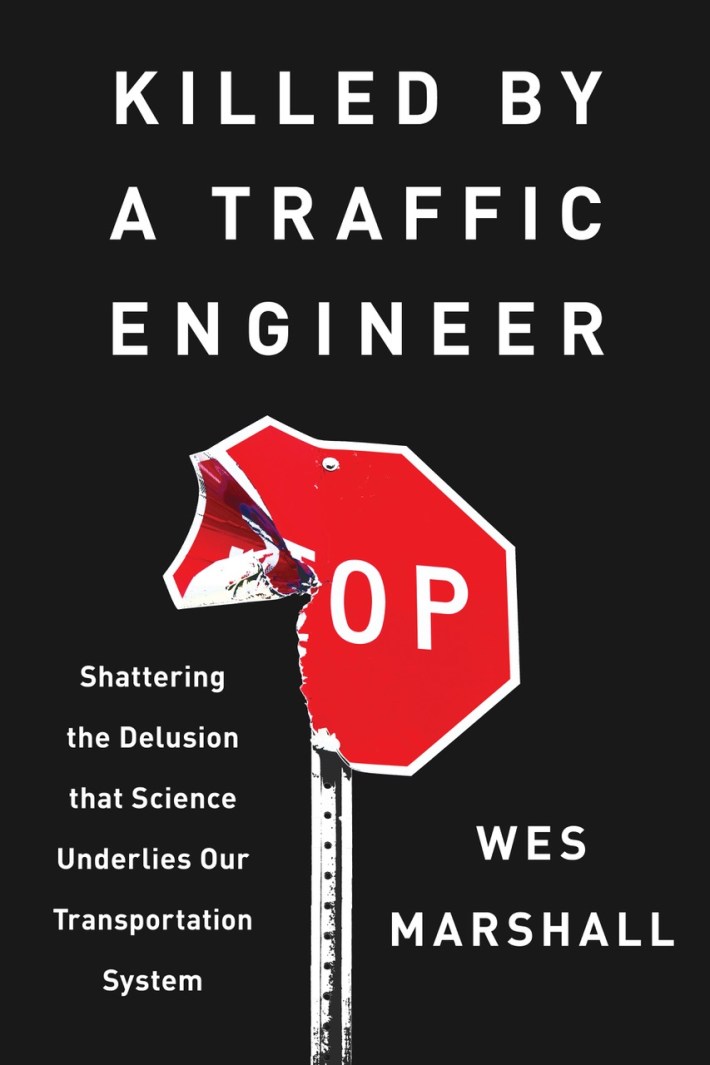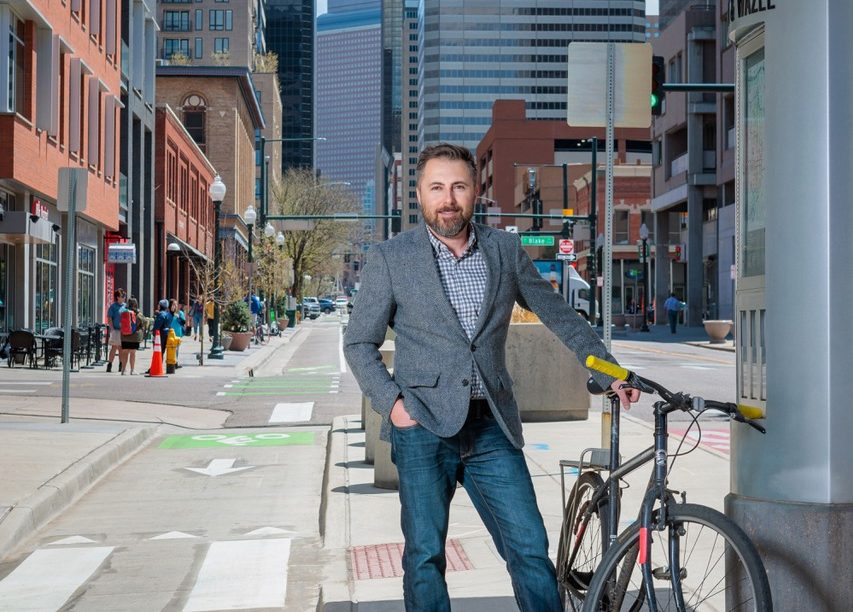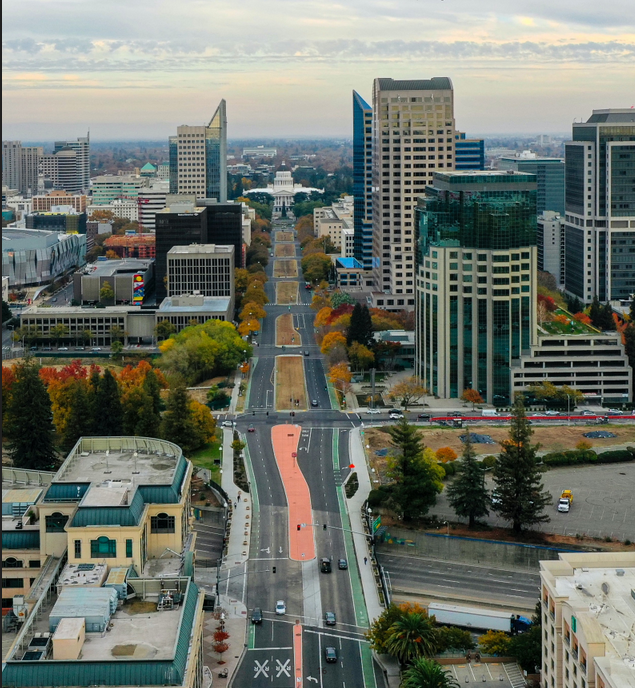Note: This post is being published concurrently at CalBike.
Wes Marshall’s new book, Killed by a Traffic Engineer, is a must-read for bike and walk advocates and anyone who cares about reforming our backward approach to road safety. At 370 pages, it’s a tome, but Marshall, a professor of civil engineering at the University of Colorado, fills it with enough humor and Simpsons references to make it an easy read.
I spoke with Marshall recently to get his take on some of the issues California is grappling with, most specifically getting Caltrans to serve needs other than vehicle throughput. As CalBike prepares to issue a report analyzing how well Caltrans serves the safety needs of people biking, walking, and taking transit, Marshall’s ideas on what’s wrong with traffic engineering and how we can fix it are particularly relevant.
Here’s our conversation, edited for length and flow.
CalBike: You made what could be a very dry subject very interesting. I totally appreciate it. Love the Simpsons references.

Wes Marshall: I am literally talking about kids dying. So, if there isn't some levity in it, it would be a tough read.
CalBike: The thing that took a lot of mental space for me while I was reading was that I was relitigating every argument I’ve had with a civil engineer over the last fifteen years.
Marshall: One of my goals was to give folks like you ammunition so the next time you’re having a discussion with someone like that, you have a little bit more insight into what they’re thinking, where they’re coming from, and where there’s leeway.
CalBike: As a total transportation nerd, this is my angry/happy place, reading your book.
Marshall: It gets a lot of people fired up.
CalBike: CalBike is running a bill, S.B. 961, for Intelligent Speed Assist. It’s gotten the most angry responses from our list, as if people feel driving above the speed limit is their God-given right. But reading your book I thought, maybe that’s understandable based on road design.
Marshall: It seems so un-American, right? The same goes for red light cameras and things like that. It devolves into “freedom” and “Big Brother.” It’s never really about safety. This is one of the things a lot of other countries do better than we do. They keep the focus of the discussion on safety. When you’re driving and you feel like you’re artificially driving lower than what the built environment is telling you to do, you feel restricted. You don’t feel the same when you’re in a place where the design matches the speed. I’m not against all the cities that are trying to just change the speed limits. You don’t get the full effect you hope but it’s heading in the right direction. At the same time, that’s not enough. You need changes in the built environment to go hand in hand with this. That’s where you’re going to get the real safety benefits.
CalBike: The other thing I wanted to ask you about is quick-build, which I think is similar to the tactical urbanism you mention in your book, testing things out. How do we get engineers to better solutions than just following the manual that isn’t very accurate? Can quick-build help?
Marshall: The way I try to teach my students when we’re talking about designing streets or anything is having the mantra that design is iterative. If you’re a mechanical engineer and you’re designing anything, you have all these prototypes. You’re testing everything and meandering towards your goal and you get closer and closer to it. For whatever reason, in transportation, we put out our final solution on the first day and just hope it works right. It doesn’t make a lot of sense, both financially or in terms of design and understanding that humans sometimes behave differently than we expect. It makes perfect sense to put something out there with cheaper materials and see how people react to it, learn from it. You might pull back in some places and double down in others, but treat it as an experiment almost. When we change an intersection, change signalization or something, you can test it. See what happens. See how people react. Traffic engineers need to go back to treating design as an iterative, incremental thing. It’s a mindset.
CalBike: I think the mindset is the trickiest thing. It's part of why this problem with Caltrans is so intractable because people are very set in their ways.
Marshall: A lot of the reasons I think engineers want to seem more authoritarian, that they know everything, is that they are scared of liability. But if we treat design as iterative and you are actually measuring something and seeing if your design is improving that something, that also protects them from liability. I think their mentality is they can’t do testing because they’re scared of liability. But I would argue that would actually help the cause. If you are using the rational process I talk about in the book. Testing things, seeing if it is helping the problem you’re setting out to solve, improving on it. That protects you from liability. If you know you have a problem, sticking your head in the sand is going to be the liability problem.
CalBike: Another issue you highlight in your book is how the ways we engineer the roads today exacerbate social inequities.
Marshall: What always bothers me, when I’m doing any safety study, I need to control for things like income and race because it’s a known fact that low-income neighborhoods have worse crash outcomes. Instead of trying to figure out why, we just control for it and don’t look for what other factors might be causing the crashes. There’s a particular street here in Denver, Montague Boulevard. It goes from a really wealthy white neighborhood near the Zoo and the Science Museum. And at that point, it's a beautiful street with two lanes, bike lanes, sidewalks, giant street trees that cover the street. But you start heading towards Aurora, out of Denver, once you kind of hit that line it becomes a four-lane. The sidewalks almost disappear, the bike lanes go away, and there are sharrows in the street. The neighborhood is more minority-focused and you're going to get worse safety outcomes on that street, regardless of what kind of cars people are driving. People can too easily fall into the trap of just blaming the people who live there as opposed to blaming the infrastructure. We forced highways through neighborhoods in a lot of places. Then you're sort of forcing people into a car. You're forcing people onto the high-injury network. We haven't given them any other options. None of this is controlled for; we just treat it as a given. We’re narrowly focused on how to fix a particular intersection as opposed to how to fix the systematic street design and neighborhood community design.
CalBike: I feel like I got an education from your book. Things that I thought were true, aren’t true. The systemic overview is a microcosm of what we do with all traffic problems, we look at very specific things and we don’t ask that “why” question you kept emphasizing.
Marshall: That speaks to crash data. We all want to have a data-driven approach to road safety and Vision Zero, but all the data is telling us we have a human error problem. So when somebody in a poor black neighborhood jaywalks, it's easy for the traffic engineers to look at the data and say, we have a human error problem. We need to teach these folks, not to jaywalk or we need to put up barriers. But when you zoom out and think about the situation we put them in, where's the nearest crosswalk? It might be half a mile away. The sidewalks we provide in between where they are and the crosswalk are probably nonexistent. When you zoom out, maybe they did the rational thing. That's where I'm trying to put the onus back on the traffic engineers, to think about all these things as a potential engineering solution, as opposed to just education and enforcement. You have to think about the crash data very differently than we do now.
CalBike: CalBike and other advocates have been working for years to try to change Caltrans. It’s like turning around a giant ocean liner. How do advocates do this? How do we change this culture?
Marshall: All our protocols are set up to design a road for not just the car capacity today but the car capacity twenty years in the future. They're not designing for safety; they're designing for this futuristic capacity. I’ve written 75 published academic papers and I feel like those are chipping away the tip of the iceberg with the problems. The book was more meant to hit the foundation. Those protocols aren’t as steeped in science as any of us think. We need to go back to the drawing board. At some level, it’s a longer-term problem: engineers acknowledging that all of these protocols should not be set in stone.
I feel like a lot of these things can change quickly. If you look at the evolution of bike lanes and bike facilities - what was the gold standard 10 years ago isn’t good anymore. If I started getting too specific, I felt like the book would age too quickly, so I tried to focus more on the fundamentals.
CalBike: One of the things that hit me in your book was the concept of “Safety Third” at some DOTs, rather than safety first—and sometimes not even third. Looking at documents from Caltrans, it seems like they don’t think safety for people who bike and walk is even their job. I get the sense that being forced to build a bike lane is annoying to them. How do we get them to feel like people who bike and walk are their constituents?
Marshall: That’s why I titled the book Killed by a Traffic Engineer. A lot of engineers are angry with me, but you’re describing exactly what I’m saying. It’s easy for them to blame those crashes on human error, either the driver or that pedestrian or bicyclist. My point is, these are systematic crashes that are happening. If we can predict them, we should be able to fix them and we’re not doing that. We can do better. We always can find money for a multimillion-dollar highway interchange, and we can never find money for a sidewalk or bike lane. You can no longer blame these on human error; we have to do something. If engineers can get over the hurdle and read the book, I think we’ll see some shifts.
CalBike: I’ve seen the shift in my town. The younger generation of engineers, probably like your students, have a more progressive attitude.
Marshall: I've seen the same thing here. There are designs out on the streets today that I would have considered a moonshot ten years ago. It is shifting. It’s hard to be patient when you know what it could be like, but we are heading in the right direction.
CalBike: Even though we don’t use Level of Service as a required standard in California, it still creeps into design discussions. Somehow, they manage to use vehicle miles traveled and come to the same conclusions as if they’d focused on level of service. What I’ve never seen considered is that twenty years from now, we expect fifty percent less driving and 100 percent more biking and transit use. Is that something we can expect from the traffic engineers of the future?
Marshall: I would hope so. I joke in the book that when we look at a bike lane that went from ten bikes a day to 100, we never extrapolate that number the way we would with cars. If we did the same thing, you could say we’re going to have 10,000 bicyclists per day in the year 2050. But we don’t use the same growth factors. Towards the end of the book, I argue that we should be focused more on the vision for the community. Instead of just assuming we need to accommodate X number of cars per day, figure out how many cars is the right number for this street and don’t provide capacity for more than that. There is nothing that says you have to design for the peak or for twenty years from now. It’s a choice we’re making. I think a lot of engineers believe that safety is steeped into all those things but it has nothing to do with safety. It’s just a thing we’re doing to fix congestion and it doesn’t even do that well.
CalBike: I think what you’re getting at is the heart of why it’s so hard to change. There’s so much of a mindset of engineers knowing what they want to do and reverse engineering the process to do that.
Marshall: We can’t often use rational arguments against car-oriented designs and car-oriented places. It has to be ridicule. Make fun of the engineers who think induced demand is a myth as opposed to explaining the rational arguments to them. Sometimes, that can be a more effective way to shift mindset.
CalBike: There are so many rational arguments against everything that they’re doing and obviously it doesn’t matter. The question becomes, how do you manifest that social shift.
Marshall: All DOTs have to spend a certain amount on safety. It’s easiest to check that box with education, so they do PSAs that say wear your seatbelt or don’t jaywalk. We know those don’t work, so why are we wasting our money on that sort of stuff. That’s a pot of money that could be used for something more tangible instead of checking a box.
CalBike: We might have to define safety. One of the things I took away from your book is that what a traffic engineer thinks when they hear the word safety is not what I would think.
Marshall: They can define anything as safety. I give the example in the book of the Legacy Parkway in Utah, where they increased the speed limit to fix wrong-way driving. Or taking away crosswalks. If we gave the engineers all the money in the world, they’re not going to fix these problems because they’re not going to spend it like any normal human being would think it should be spent. What the book is trying to do is change those fundamentals. If we change what we’re actually measuring when it comes to safety, that’s a step in the right direction. If we are treating our crash data like there’s a potential engineering solution as opposed to just blaming human error, that’s a step in the right direction. Then, we can start looking at safety for what it is.






